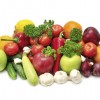 Fruits and vegetables should be a main component of every meal. They are low in calories and provide a number of vitamins that you need in your diet. By making half of your plate fruits and vegetables at every meal, you will reduce your risk for chronic diseases and may even protect yourself against certain types of cancer. This 4-page fact sheet provides information on fruits and vegetables and includes tips on how to add more of them to your diet. Written by Jonathan Holzinger, Karla Shelnutt, and Gail Kauwell, and published by the UF Department of Family Youth and Community Sciences, February 2013.
Fruits and vegetables should be a main component of every meal. They are low in calories and provide a number of vitamins that you need in your diet. By making half of your plate fruits and vegetables at every meal, you will reduce your risk for chronic diseases and may even protect yourself against certain types of cancer. This 4-page fact sheet provides information on fruits and vegetables and includes tips on how to add more of them to your diet. Written by Jonathan Holzinger, Karla Shelnutt, and Gail Kauwell, and published by the UF Department of Family Youth and Community Sciences, February 2013.
http://edis.ifas.ufl.edu/fy1348
Category: Health & Nutrition
Abdominal Obesity (FCS80021/FY1347)
 Santa Claus, Winnie the Pooh®, and Shrek® … what do these three characters have in common? You probably know them for being jolly and for having extra fat around their waists, also known as “abdominal obesity.” Although this may be cute in fairy tales or movies, abdominal obesity can be a serious health risk in the real world. Abdominal obesity, also known as central adiposity, is a buildup of fat tissue around the waist or midsection. It is a risk factor for certain health conditions. Read this 4-page fact sheet to find out more about the health risks of abdominal obesity and ways to prevent or treat it. Written by Erica Bub, Karla Shelnutt, and Gail Kauwell, and published by the UF Department of Family Youth and Community Sciences, February 2013.
Santa Claus, Winnie the Pooh®, and Shrek® … what do these three characters have in common? You probably know them for being jolly and for having extra fat around their waists, also known as “abdominal obesity.” Although this may be cute in fairy tales or movies, abdominal obesity can be a serious health risk in the real world. Abdominal obesity, also known as central adiposity, is a buildup of fat tissue around the waist or midsection. It is a risk factor for certain health conditions. Read this 4-page fact sheet to find out more about the health risks of abdominal obesity and ways to prevent or treat it. Written by Erica Bub, Karla Shelnutt, and Gail Kauwell, and published by the UF Department of Family Youth and Community Sciences, February 2013.
http://edis.ifas.ufl.edu/fy1347
Raising Healthy Children: Milk and Egg Allergies (FCS80020/FY1346)
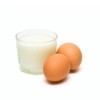 Milk and eggs are familiar, nutritious foods that most children enjoy, but these foods can cause problems for children with milk and egg allergies. If your child is allergic to milk or eggs, you need to consider steps you and your child can take to avoid these foods, and you need to make sure your child gets enough of the proper nutrients, especially if certain foods are removed from his or her diet. This 5-page fact sheet will help you learn more about milk and egg allergies and how to make sure your allergic child stays safe. Written by Jonathan Holzinger, Karla Shelnutt, and Gail Kauwell, and published by the UF Department of Family Youth and Community Sciences, February 2013.
Milk and eggs are familiar, nutritious foods that most children enjoy, but these foods can cause problems for children with milk and egg allergies. If your child is allergic to milk or eggs, you need to consider steps you and your child can take to avoid these foods, and you need to make sure your child gets enough of the proper nutrients, especially if certain foods are removed from his or her diet. This 5-page fact sheet will help you learn more about milk and egg allergies and how to make sure your allergic child stays safe. Written by Jonathan Holzinger, Karla Shelnutt, and Gail Kauwell, and published by the UF Department of Family Youth and Community Sciences, February 2013.
http://edis.ifas.ufl.edu/fy1346
Raising Healthy Children: Packing a Peanut-Free Lunch (FCS80019/FY1345)
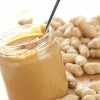 Peanut butter is a staple in the diets of many children, but it can cause serious problems for those with a peanut allergy. Knowing how to identify foods that contain peanuts, what to pack for school lunches, and how to reduce accidental contact with peanuts will help keep children with peanut allergies safe when they are away from home. This 5-page fact sheet was written by Sarah Schmidt, Karla Shelnutt, and Gail Kauwell, and published by the UF Department of Family Youth and Community Sciences, February 2013.
Peanut butter is a staple in the diets of many children, but it can cause serious problems for those with a peanut allergy. Knowing how to identify foods that contain peanuts, what to pack for school lunches, and how to reduce accidental contact with peanuts will help keep children with peanut allergies safe when they are away from home. This 5-page fact sheet was written by Sarah Schmidt, Karla Shelnutt, and Gail Kauwell, and published by the UF Department of Family Youth and Community Sciences, February 2013.
http://edis.ifas.ufl.edu/fy1345
Pureed Foods and Fiber (FSHN12-16/FS209)
 People with swallowing problems who require a puréed diet may not meet their recommended intake of fiber. But puréed diets can be planned to achieve fiber recommendations by choosing higher-fiber puréed foods often. And a variety of fiber ingredients are available that can be added to puréed foods. This 4-page fact sheet was written by Wendy J. Dahl, and published by the UF Department of Food Science and Human Nutrition, January 2013.
People with swallowing problems who require a puréed diet may not meet their recommended intake of fiber. But puréed diets can be planned to achieve fiber recommendations by choosing higher-fiber puréed foods often. And a variety of fiber ingredients are available that can be added to puréed foods. This 4-page fact sheet was written by Wendy J. Dahl, and published by the UF Department of Food Science and Human Nutrition, January 2013.
http://edis.ifas.ufl.edu/fs209
Datos sobre las vitaminas (FCS8808S/FY1343)
 Las vitaminas son compuestos químicos que el cuerpo utiliza de muchas maneras. Nosotros necesitamos obtener las vitaminas en nuestra dieta porque nuestros cuerpos no las pueden crear. Existen 13 tipos de vitaminas que han sido identificadas como nutrientes importantes para los humanos. This 3-page fact sheet was written by R. Elaine Turner and Wendy J. Dahl, and published by the UF Department of Family Youth and Community Sciences, November 2012.
Las vitaminas son compuestos químicos que el cuerpo utiliza de muchas maneras. Nosotros necesitamos obtener las vitaminas en nuestra dieta porque nuestros cuerpos no las pueden crear. Existen 13 tipos de vitaminas que han sido identificadas como nutrientes importantes para los humanos. This 3-page fact sheet was written by R. Elaine Turner and Wendy J. Dahl, and published by the UF Department of Family Youth and Community Sciences, November 2012.
http://edis.ifas.ufl.edu/fy1343
Datos sobre la niacina (FCS8669S/FY1340)
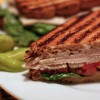 La niacina es una de las vitaminas del grupo B (vitamina B3). Nuestro cuerpo necesita la niacina para usar los carbohidratos, las grasas y las proteínas. La niacina también se necesita para reparar el ADN y para el uso normal del calcio en el cuerpo. This 2-page fact sheet was written by R. Elaine Turner y Wendy J. Dahl, and published by the UF Department of Family Youth and Community Sciences, November 2012.
La niacina es una de las vitaminas del grupo B (vitamina B3). Nuestro cuerpo necesita la niacina para usar los carbohidratos, las grasas y las proteínas. La niacina también se necesita para reparar el ADN y para el uso normal del calcio en el cuerpo. This 2-page fact sheet was written by R. Elaine Turner y Wendy J. Dahl, and published by the UF Department of Family Youth and Community Sciences, November 2012.
http://edis.ifas.ufl.edu/fy1340
Facts about Niacin (FCS8669/FY212)
 Niacin is one of the B vitamins (vitamin B3). Our bodies need niacin to use the energy in carbohydrates, fats, and proteins. Niacin also is needed for DNA repair and for the normal use of calcium in the body. This 2-page fact sheet was written by R. Elaine Turner and Wendy J. Dahl, and published by the UF Department of Family Youth and Community Sciences, November 2012.
Niacin is one of the B vitamins (vitamin B3). Our bodies need niacin to use the energy in carbohydrates, fats, and proteins. Niacin also is needed for DNA repair and for the normal use of calcium in the body. This 2-page fact sheet was written by R. Elaine Turner and Wendy J. Dahl, and published by the UF Department of Family Youth and Community Sciences, November 2012.
http://edis.ifas.ufl.edu/fy212
Being Smart About Gluten and Gluten-Free Issues, Part 1: What Are the Health Concerns Surrounding Gluten? (WC133/WC133)
 Are you an inquisitive consumer who asks what the big deal is about gluten free? Ask no more; this article is the first in a three–part series about gluten. This 7-page fact sheet identifies health conditions surrounding the ingestion of gluten. The resources used in this article are research and evidence based and/or peer reviewed to provide straightforward and simple information about a few gluten-related topics. Written by Abigail Dicks, Amy Harder, and Amy Simonne, and published by the UF Department of Agricultural Education and Communication, January 2013.
Are you an inquisitive consumer who asks what the big deal is about gluten free? Ask no more; this article is the first in a three–part series about gluten. This 7-page fact sheet identifies health conditions surrounding the ingestion of gluten. The resources used in this article are research and evidence based and/or peer reviewed to provide straightforward and simple information about a few gluten-related topics. Written by Abigail Dicks, Amy Harder, and Amy Simonne, and published by the UF Department of Agricultural Education and Communication, January 2013.
http://edis.ifas.ufl.edu/wc133
De compras para salud: Granos integrales (FSHN1013S/FS217)
 Los granos incluyen alimentos como el pan, la pasta, la avena, y las galletas. Cualquier alimento hecho con trigo, avena, arroz, maíz, cebada u otro cereal es considerado un grano. Sustituir los productos refinados por los de granos integrales puede ayudar con el manejo del peso y a disminuir el riesgo de enfermedades crónicas. This 4-page fact sheet was written by Food Science and Human Nutrition, and published by the UF Department of Wendy J. Dahl y Lauren Foster, January 2013.
Los granos incluyen alimentos como el pan, la pasta, la avena, y las galletas. Cualquier alimento hecho con trigo, avena, arroz, maíz, cebada u otro cereal es considerado un grano. Sustituir los productos refinados por los de granos integrales puede ayudar con el manejo del peso y a disminuir el riesgo de enfermedades crónicas. This 4-page fact sheet was written by Food Science and Human Nutrition, and published by the UF Department of Wendy J. Dahl y Lauren Foster, January 2013.
http://edis.ifas.ufl.edu/fs217
Datos sobre la riboflavina (FCS8668S/FY1344)
 La riboflavina es una de las vitaminas del grupo B. También es conocida como la vitamina B2. Nosotros necesitamos la riboflavina para utilizar los carbohidratos, grasas y proteínas en los alimentos que comemos. La riboflavina ayuda a utilizar estos nutrientes en energía para el cuerpo y para funciones como antioxidante. La riboflavina también se necesita para utilizar correctamente las vitaminas niacina, el ácido fólico y la vitamina B6. This 2-page fact sheet was written by R. Elaine Turner y Wendy J. Dahl, and published by the UF Department of Family Youth and Community Sciences, November 2012.
La riboflavina es una de las vitaminas del grupo B. También es conocida como la vitamina B2. Nosotros necesitamos la riboflavina para utilizar los carbohidratos, grasas y proteínas en los alimentos que comemos. La riboflavina ayuda a utilizar estos nutrientes en energía para el cuerpo y para funciones como antioxidante. La riboflavina también se necesita para utilizar correctamente las vitaminas niacina, el ácido fólico y la vitamina B6. This 2-page fact sheet was written by R. Elaine Turner y Wendy J. Dahl, and published by the UF Department of Family Youth and Community Sciences, November 2012.
http://edis.ifas.ufl.edu/fy1344
Datos sobre los minerales (FCS8809S/FY1341)
 Los minerales son substancias como el calcio, el fósforo, el hierro y el zinc que se encuentran en las rocas y la tierra. También, se necesitan para tener una nutrición adecuada. Hay 16 minerales diferentes que sabemos que son necesarios en nuestra dieta. Varios otros minerales pueden ser necesarios en cantidades pequeñas. This 4-page fact sheet was written by R. Elaine Turner y Wendy J. Dahl, and published by the UF Department of Family Youth and Community Sciences, November 2012.
Los minerales son substancias como el calcio, el fósforo, el hierro y el zinc que se encuentran en las rocas y la tierra. También, se necesitan para tener una nutrición adecuada. Hay 16 minerales diferentes que sabemos que son necesarios en nuestra dieta. Varios otros minerales pueden ser necesarios en cantidades pequeñas. This 4-page fact sheet was written by R. Elaine Turner y Wendy J. Dahl, and published by the UF Department of Family Youth and Community Sciences, November 2012.
http://edis.ifas.ufl.edu/fy1341
MyPlate for Dysphagia (FHSN1214/FS207)
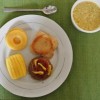 Resources and tools at ChooseMyPlate.gov that provide clear, actionable information about how to make better food choices can be easily adapted for persons with swallowing difficulties (dysphagia) that require texture-modified foods. This 3-page fact sheet was written by Jamila R. Lepore, Nancy Gal, and Wendy J. Dahl, and published by the UF Department of Food Science and Human Nutrition, December 2012.
Resources and tools at ChooseMyPlate.gov that provide clear, actionable information about how to make better food choices can be easily adapted for persons with swallowing difficulties (dysphagia) that require texture-modified foods. This 3-page fact sheet was written by Jamila R. Lepore, Nancy Gal, and Wendy J. Dahl, and published by the UF Department of Food Science and Human Nutrition, December 2012.
http://edis.ifas.ufl.edu/fs207
Sensory Acceptability of Pureed Foods (FSHN1213/FS206)
 It is important that we enjoy the food we eat. This makes for a better quality of life. This is no different for those people needing to be on puréed diets due to swallowing problems. And just like you wouldn’t want to serve guests a recipe without trying it first, you don’t want to serve a puréed food without knowing that it is appealing. This 5-page fact sheet was written by Jamila R. Lepore and Wendy J. Dahl, and published by the UF Department of Food Science and Human Nutrition, November 2012.
It is important that we enjoy the food we eat. This makes for a better quality of life. This is no different for those people needing to be on puréed diets due to swallowing problems. And just like you wouldn’t want to serve guests a recipe without trying it first, you don’t want to serve a puréed food without knowing that it is appealing. This 5-page fact sheet was written by Jamila R. Lepore and Wendy J. Dahl, and published by the UF Department of Food Science and Human Nutrition, November 2012.
http://edis.ifas.ufl.edu/fs206
La aceptabilidad sensorial de los alimentos en pure (FSHN1213S/FS216)
 La evaluación sensorial es el proceso en el que utilizamos nuestros sentidos (gusto, olfato, tacto, vista) y su aplicación para la determinación de la aceptabilidad de los alimentos. ¡Simplemente, se están evaluando los alimentos para asegurarse que se ven, huelen y saben delicioso! This 6-page fact sheet was written by Jamila R. Lepore and Wendy J. Dahl, and published by the UF Department of Food Science and Human Nutrition, December 2012.
La evaluación sensorial es el proceso en el que utilizamos nuestros sentidos (gusto, olfato, tacto, vista) y su aplicación para la determinación de la aceptabilidad de los alimentos. ¡Simplemente, se están evaluando los alimentos para asegurarse que se ven, huelen y saben delicioso! This 6-page fact sheet was written by Jamila R. Lepore and Wendy J. Dahl, and published by the UF Department of Food Science and Human Nutrition, December 2012.
http://edis.ifas.ufl.edu/fs216
Datos sobre la Tiamina (FCS8667S/FY1342)
 La tiamina es una de las vitaminas del grupo B. Es también llamada B1. Nosotros necesitamos tiamina para utilizar los carbohidratos que comemos. La tiamina ayuda a transformar los carbohidratos en energía para el cuerpo. El cuerpo también necesita tiamina para usar algunos de los aminoácidos que componen las proteínas. This 2-page fact sheet was written by R. Elaine Turner y Wendy J. Dahl, and published by the UF Department of Family Youth and Community Sciences, November 2012.
La tiamina es una de las vitaminas del grupo B. Es también llamada B1. Nosotros necesitamos tiamina para utilizar los carbohidratos que comemos. La tiamina ayuda a transformar los carbohidratos en energía para el cuerpo. El cuerpo también necesita tiamina para usar algunos de los aminoácidos que componen las proteínas. This 2-page fact sheet was written by R. Elaine Turner y Wendy J. Dahl, and published by the UF Department of Family Youth and Community Sciences, November 2012.
http://edis.ifas.ufl.edu/fy1342
Living Well to Keep Your Pressure Down (FCS8690/FY305)
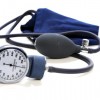 High blood pressure, or hypertension, can cause serious health problems. It makes your heart work harder and can damage your blood vessels even if you feel okay. Everyone should have their blood pressure checked regularly. If you have certain risk factors you are more likely to have high blood pressure. Follow these recommendations to help reduce your risk for high blood pressure. This 6-page fact sheet was written by Linda B. Bobroff, and published by the UF Department of Family Youth and Community Sciences, January 2013.
High blood pressure, or hypertension, can cause serious health problems. It makes your heart work harder and can damage your blood vessels even if you feel okay. Everyone should have their blood pressure checked regularly. If you have certain risk factors you are more likely to have high blood pressure. Follow these recommendations to help reduce your risk for high blood pressure. This 6-page fact sheet was written by Linda B. Bobroff, and published by the UF Department of Family Youth and Community Sciences, January 2013.
http://edis.ifas.ufl.edu/fy305
Healthy Living: Tips for Staying Regular (FCS8565/FY072)
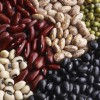 Constipation means having a bowel movement fewer than three times a week. Stools are usually hard and can be painful to pass. Constipation is common among older adults.This 1-page fact sheet was written by Linda B. Bobroff, and published by the UF Department of Family Youth and Community Sciences, January 2013.
Constipation means having a bowel movement fewer than three times a week. Stools are usually hard and can be painful to pass. Constipation is common among older adults.This 1-page fact sheet was written by Linda B. Bobroff, and published by the UF Department of Family Youth and Community Sciences, January 2013.
http://edis.ifas.ufl.edu/fy072
Mange in Companion Animals (ENY289/IN953)
 Mange is a persistent skin condition of mammals caused by infestation with parasitic mites. Mites are tiny arthropods, usually less than 1 mm in length and difficult to see with the naked eye. Adult mites have eight legs, and larvae have six. The effect of the mites on the animal’s skin, called “mange,” is the most visible sign of an infestation. This 6-page fact sheet describes several skin conditions commonly caused by parasitic mites in domestic animals. Written by E. N. I. Weeks and P. E. Kaufman, and published by the UF Department of Entomology and Nematology, September 2012.
Mange is a persistent skin condition of mammals caused by infestation with parasitic mites. Mites are tiny arthropods, usually less than 1 mm in length and difficult to see with the naked eye. Adult mites have eight legs, and larvae have six. The effect of the mites on the animal’s skin, called “mange,” is the most visible sign of an infestation. This 6-page fact sheet describes several skin conditions commonly caused by parasitic mites in domestic animals. Written by E. N. I. Weeks and P. E. Kaufman, and published by the UF Department of Entomology and Nematology, September 2012.
http://edis.ifas.ufl.edu/in953
Alimentos funcionales (FSHN1217S/FS213)
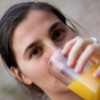 Un alimento funcional es definido comúnmente como un alimento que proveen beneficios más allá de la nutrición básica proporcionada por dicho alimento. El beneficio adicional se debe a un componente en el alimento que ofrece beneficios físicos o biológicos, como por ejemplo, beneficios funcionales. This 4-page fact sheet was written by Amanda Ford y Wendy J. Dahl, and published by the UF Department of Food Science and Human Nutrition, November 2012.
Un alimento funcional es definido comúnmente como un alimento que proveen beneficios más allá de la nutrición básica proporcionada por dicho alimento. El beneficio adicional se debe a un componente en el alimento que ofrece beneficios físicos o biológicos, como por ejemplo, beneficios funcionales. This 4-page fact sheet was written by Amanda Ford y Wendy J. Dahl, and published by the UF Department of Food Science and Human Nutrition, November 2012.
http://edis.ifas.ufl.edu/fs213